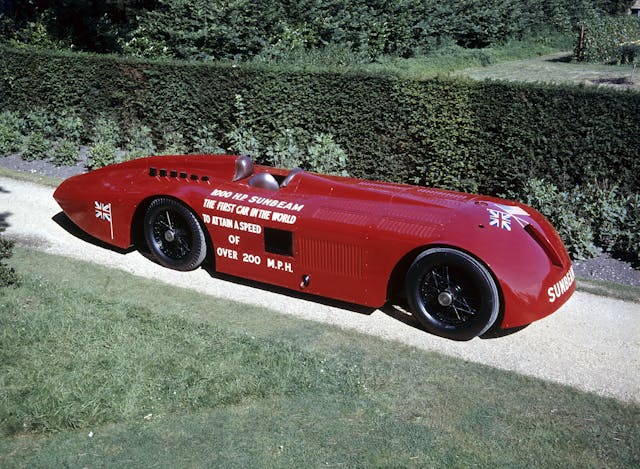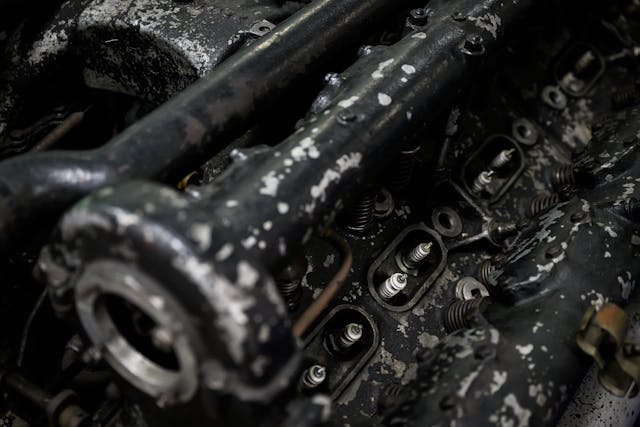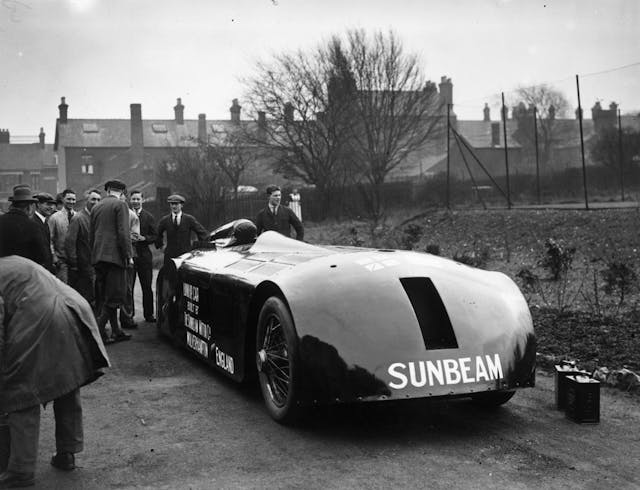First car to go 200 mph needs your help to roar again
In 1927, Major Henry Segrave piloted a Sunbeam land-speed car to 203.79 mph on the sands of Daytona Beach, Florida, making it the first car to record a speed over 200 mph. The National Motor Museum, located in Beaulieu near the southern coast of England, hopes to get the massive racer running and bring it back to Daytona three years from now, on the 100th anniversary of the achievement. What better way to celebrate the feat than with the thundering report of the car’s twin 22.5-liter V-12 aircraft engines?
The National Motor Museum has calculated that it will take £300,000 (about $383,000) to rebuild the two monster engines, freshen up the car, and ship it across the Atlantic. After announcing the plan last March, the museum has already raised £50,000.

Museum visitors can currently see the car’s chassis, which is on display while other restoration work is being done. Later this month, the museum’s manager and chief engineer, Doug Hill, along with senior engineer Ian Stanfield will host a talk highlighting the restoration efforts. They’ll be joined by Richard Noble, who held the outright land-speed record for driving the Thrust 2 to 633 mph in 1983. Tickets for the event will benefit the restoration of the Sunbeam.
Plans for the huge, sleek racer include the trip to Daytona, naturally, but also a tour around Europe and America so that racing fans and history buffs can get an up-close look at the machine and also hear it in all of its glory. One of the DOHC, 48-valve engines seems to be up and running for the first time since before WWII, after a rebuild that repaired the aged and oxidized machinery, but there’s still a long way to go.

“Funds are now needed to gear up a level to complete the second engine build and ultimately the full restoration. Donations for the Sunbeam 1000hp Restoration Campaign can be made online. Sponsors and corporate donors who would like to be associated with the campaign are urged to get in touch with the Museum’s Development team,” said National Motor Museum’s Michelle Kirwan.
This record-setting car would be a sight to behold, as it highlights a different era of land speed racing than anything we’ve experienced. With 24 cylinders and nearly 1000 hp on tap, it would sound unlike anything we’ve seen in competition. We wish the National Motor Museum luck in reaching its goal and preserving this wonderful piece of history and hope to see the Sunbeam hit the beach in three years!
***
Check out the Hagerty Media homepage so you don’t miss a single story, or better yet, bookmark it. To get our best stories delivered right to your inbox, subscribe to our newsletters.



I would love to see this car and hear it run.
https://youtu.be/DBzts4iPcnA?si=3EH7TaWv3Iqcc2GL
Thanks for that link Gary, that was a really good watch.
I might just use that as a question this year at one of the shows my club sponsors ? Few will know that one I’ll bet.
Oh Oh,,I just might have let the cat out of the bag,,,,,, DOWWWWW !
What a crazy tube of a car. I would love to hear that thing at full roar.
I went to the National Motor Museum at Beaulieu (pronounced Byoo-lee) many years ago. Excellent museum! Among many other interesting vehicles, they have quite a collection of British Land Speed record cars. Seems like most of them were Sunbeams – at least that’s what I remember. I remember hoping the Thrust SSC was among the collection, but it lives somewhere else. So I just have to be content staring at my model of it…
although it would be awesome to hear it run again the corrosive nature of the salt and the value of the car seem to make this a bad idea…The motorcycle I crewed on which in its time set 11 national records when it was finally retired in 2019,had to be almost completely taken apart after each time it ran just to get all of the salt out of everywhere,and you wouldn’t imagine some of the places that salt can get in to…I cannot imagine what it would take to dis-assemble this beast after running out there. but it would likely be equal to,or greater then what they are trying to raise now..More suited I think,to run on a closed course at this point after it is re-awakened which would seem a far better idea for its long term preservation.